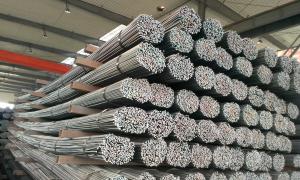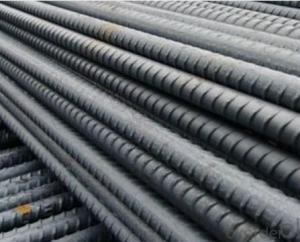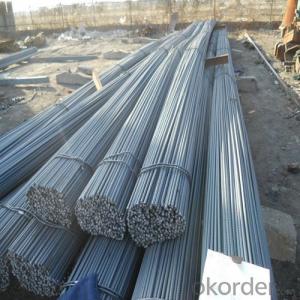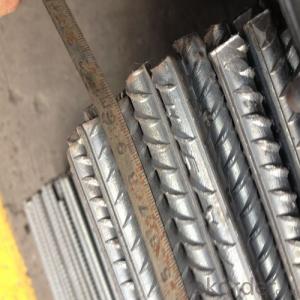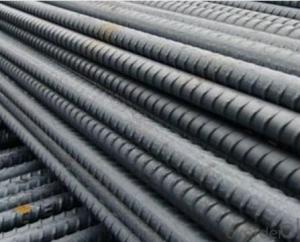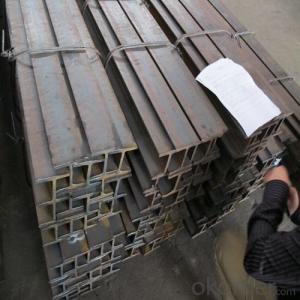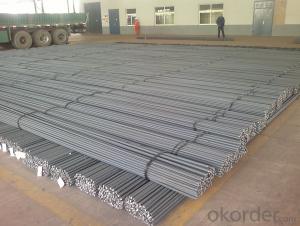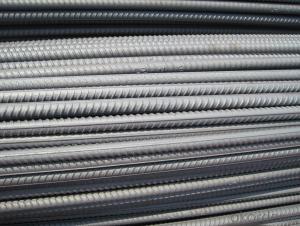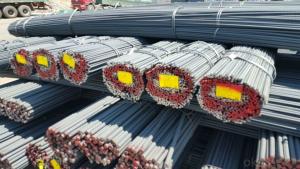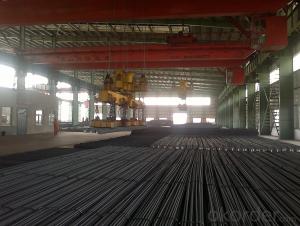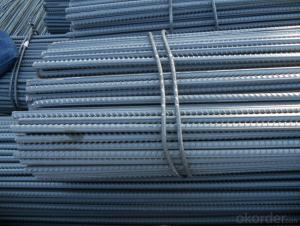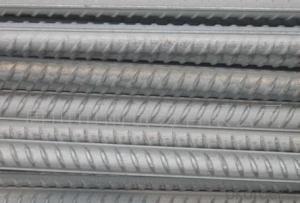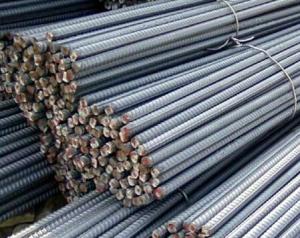Cold Rolled Deformed Bar CRB550
- Loading Port:
- China Main Port
- Payment Terms:
- TT OR LC
- Min Order Qty:
- -
- Supply Capability:
- -
OKorder Service Pledge
OKorder Financial Service
You Might Also Like
Cold Rolled Techniques
Yield Point: 545-565mpa
Theoretical weight and section area of each diameter as below for your information:
Diameter(mm) | Section area (mm²) | Mass(kg/m) | Weight of 12m (kg) | Pcs/ton |
6 | 28.27 | 0.222 | 2.664 | 375.38 |
8 | 50.27 | 0.395 | 4.74 | 210.97 |
10 | 78.54 | 0.617 | 7.404 | 135.06 |
12 | 113.1 | 0.888 | 10.656 | 93.84 |
14 | 153.9 | 1.21 | 14.52 | 68.87 |
16 | 201.1 | 1.58 | 18.96 | 52.74 |
18 | 254.5 | 2.00 | 24 | 41.67 |
20 | 314.2 | 2.47 | 29.64 | 33.74 |
22 | 380.1 | 2.98 | 35.76 | 27.96 |
25 | 490.9 | 3.85 | 46.2 | 21.65 |
28 | 615.8 | 4.83 | 57.96 | 17.25 |
32 | 804.2 | 6.31 | 75.72 | 13.21 |
36 | 1018 | 7.99 | 98.88 | 10.43 |
40 | 1257 | 9.87 | 118.44 | 8.44 |
50 | 1964 | 15.42 | 185.04 | 5.40 |
- Q: Can steel rebars be used in structures with extreme temperature variations?
- Structures that experience extreme temperature variations can generally utilize steel rebars. Steel possesses exceptional durability and strength due to its high melting point, making it suitable for various construction applications. However, there are several factors to consider when employing steel rebars in such structures. To begin with, steel exhibits thermal expansion, meaning it expands and contracts as temperatures fluctuate. If not properly addressed, this expansion and contraction can potentially stress and strain the structure. Engineers and architects counteract this issue by implementing design techniques such as incorporating expansion joints or allowing for thermal movement. These measures accommodate the steel's thermal expansion and prevent damage. Additionally, extreme temperature variations can impact the mechanical properties of steel. Exposure to high temperatures can cause steel to lose its strength and stiffness, compromising the structural integrity. Conversely, low temperatures can make the steel brittle, increasing the likelihood of cracks or fractures. Therefore, it is crucial to select steel rebars of the appropriate grade and quality, specifically designed to withstand the expected temperature variations. Furthermore, the type and purpose of the structure should be taken into consideration. For example, in structures where extreme temperature variations are anticipated, such as bridges or buildings in regions with hot summers and cold winters, thermal insulation or other measures should be incorporated into the design. These measures prevent excessive heat transfer or the accumulation of thermal stress. In conclusion, steel rebars can be employed in structures experiencing extreme temperature variations, but careful considerations must be made. By accounting for thermal expansion, selecting suitable steel grades, and incorporating design techniques to accommodate temperature changes, the structural integrity and performance can be maintained. This ensures the safety and longevity of the construction.
- Q: How are steel rebars protected from vandalism during construction?
- Steel rebars are often protected from vandalism during construction by implementing security measures such as fencing around the construction site, hiring security personnel to monitor the area, and installing surveillance cameras. Additionally, construction companies may choose to store the rebars in secure locations within the site or cover them with protective materials to deter potential vandals.
- Q: What is the purpose of using steel rebars in construction?
- The purpose of using steel rebars in construction is to provide reinforcement and strength to concrete structures. Steel rebars enhance the structural integrity of buildings, bridges, and other constructions by improving their resistance to tension forces, preventing cracks, and enhancing overall durability.
- Q: What are the different types of steel rebars used in railway bridges?
- There are several types of steel rebars used in railway bridges, including plain carbon steel rebars, epoxy-coated rebars, and stainless steel rebars. Each type of rebar offers unique properties and benefits to ensure the durability and strength of railway bridges.
- Q: Are steel rebars suitable for use in structures with high wind loads?
- Structures with high wind loads can benefit from the use of steel rebars. Also known as reinforcing bars, steel rebars are commonly utilized in construction to provide strength and stability to reinforced concrete structures. Their purpose is to withstand significant tensile forces and play a crucial role in maintaining the structural integrity of buildings, particularly in areas prone to high wind loads. Steel rebars possess several advantages that render them suitable for structures with high wind loads. Firstly, steel exhibits exceptional tensile strength, enabling it to resist the forces generated by wind loads. Unlike materials such as timber or concrete, steel rebars possess remarkable ductility, allowing them to absorb and redistribute the energy produced by wind-induced vibrations. Secondly, steel rebars demonstrate remarkable durability and resistance to corrosion. This characteristic is vital for structures exposed to harsh weather conditions, including strong winds. Utilizing steel rebars mitigates the risk of structural deterioration or weakening over time caused by wind-induced stresses. Furthermore, steel rebars offer ease in molding and shaping, accommodating the specific design requirements of the structure. This flexibility empowers engineers to create and construct buildings capable of withstanding various wind loads experienced in different regions. In conclusion, due to their high tensile strength, durability, and resistance to corrosion, steel rebars are an ideal choice for structures with high wind loads. They provide the necessary reinforcement to ensure the longevity and safety of the structure under challenging wind conditions.
- Q: How are steel rebars cut on-site?
- Steel rebars are typically cut on-site using a variety of tools, such as electric cutters, oxyacetylene torches, or portable hydraulic shears. These tools provide the necessary power and precision to cut through the strong steel bars, allowing them to be customized to the desired lengths or shapes required for construction projects.
- Q: What is the difference between mild steel rebars and high-strength steel rebars?
- Mild steel rebars and high-strength steel rebars are two different types of reinforcement bars used in construction. The key difference between these two lies in their composition and mechanical properties. Mild steel rebars, also known as low carbon steel rebars, are made from steel with a relatively low carbon content. Typically, they have a carbon content of about 0.15% to 0.30%. These rebars are commonly used in general construction projects where the concrete structure does not require high tensile strength. Mild steel rebars have a relatively lower yield strength and ultimate tensile strength compared to high-strength steel rebars. On the other hand, high-strength steel rebars, also known as high tensile strength rebars or HSD bars, are made from steel with a higher carbon content, typically ranging from 0.40% to 0.60%. These rebars are specially designed to provide superior strength, durability, and load-bearing capacity. High-strength steel rebars have a significantly higher yield strength and ultimate tensile strength compared to mild steel rebars. This makes them suitable for use in critical structures that require a high load-bearing capacity, such as bridges, high-rise buildings, and industrial structures. Another important difference between mild steel rebars and high-strength steel rebars is their ductility. Mild steel rebars have better ductility, meaning they can undergo more deformation before failing. This property allows mild steel rebars to absorb more energy during an earthquake or other dynamic loads, making them suitable for seismic zones. High-strength steel rebars, on the other hand, have lower ductility but higher stiffness and strength, making them more resistant to extreme loads and providing better structural integrity. It is important to note that while high-strength steel rebars offer superior strength and load-bearing capacity, they are also more expensive compared to mild steel rebars. Therefore, the choice between these two types of rebars depends on the specific requirements of the construction project, including the structural design, load conditions, and budget constraints.
- Q: Are steel rebars suitable for use in aggressive environments?
- Yes, steel rebars are suitable for use in aggressive environments. Steel rebars are commonly used in construction projects, including those in aggressive environments such as coastal areas, chemical plants, and wastewater treatment facilities. They possess excellent durability, strength, and corrosion resistance properties, making them highly suitable for withstanding aggressive elements like saltwater, chemicals, and moisture. Additionally, proper protective coatings can be applied to enhance their resistance to corrosion, ensuring their long-term performance in aggressive environments.
- Q: How do steel rebars contribute to the load-bearing capacity of a structure?
- Steel rebars contribute to the load-bearing capacity of a structure by reinforcing the concrete and increasing its strength and durability. They provide tensile strength, which helps the structure resist bending and cracking under heavy loads, making it more resistant to structural failure.
- Q: What are the different types of steel rebars used in road bridges?
- There are primarily two types of steel rebars commonly used in road bridges: carbon steel rebars and stainless steel rebars. Carbon steel rebars are the most widely used and cost-effective option, known for their strength and durability. On the other hand, stainless steel rebars are corrosion-resistant, making them suitable for bridges exposed to harsh environmental conditions or those built near bodies of water. Each type of rebar has its own advantages and is selected based on the specific requirements and conditions of the bridge project.
Send your message to us
Cold Rolled Deformed Bar CRB550
- Loading Port:
- China Main Port
- Payment Terms:
- TT OR LC
- Min Order Qty:
- -
- Supply Capability:
- -
OKorder Service Pledge
OKorder Financial Service
Similar products
Hot products
Hot Searches
Related keywords
